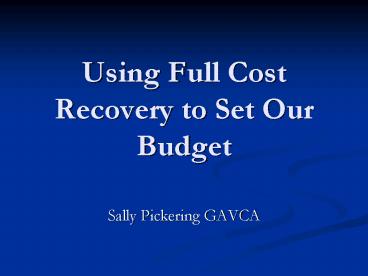Using Full Cost Recovery to Set Our Budget - PowerPoint PPT Presentation
1 / 15
Title:
Using Full Cost Recovery to Set Our Budget
Description:
Keep the names of each budget area as close to the names required ... Add in any costs specific to this project eg. room hire, printing, volunteer expenses etc. ... – PowerPoint PPT presentation
Number of Views:36
Avg rating:3.0/5.0
Title: Using Full Cost Recovery to Set Our Budget
1
Using Full Cost Recovery to Set Our Budget
- Sally Pickering GAVCA
2
Decide objectives
- Agree a Business Plan of what you want to do,
what it will cost to do it and then find the
money to pay for this - rather than
- seeing how much money we have, and deciding what
to spend it on.
3
Identify projects and name them
- Group all the activities of your organisation
into projects, according to funding streams,
staff posts or or different areas of work - This exercise really helps you think about what
your organisation is actually doing. - Smaller organisations may not have separate
projects.
4
What about all the other stuff we do?
- These are the areas that often get forgotten and
arent fully costed, and are your Governance and
Management activities. - Time spent on these tasks need to be included in
your Overheads.
5
What are your costs?
- Make a list of all the possible areas of expense
that you might have. - Keep the names of each budget area as close to
the names required by funders as possible, to
make reporting easier.
6
Project Costs versus Overhead Costs
- All expenses are either
- Project costs wouldnt be incurred if that area
of work was not done OR - Overheads (core costs) would be incurred
whether or not that area of work was done. - Its up to you to decide what you allocate to
overheads, but aim is to keep overheads as low as
possible.
7
Calculate your Overheads
- Accommodation Costs
- heat, light, water
- rent, rates
- cleaning, maintenance, repairs
- Management Costs salaries of
- part or all of manager
- ICT support
- finance officer
- administrator
8
- Administration Costs (office costs)
- publicity
- telephones
- subscriptions
- insurance
- Governance Costs
- monitoring and evaluation
- Policy development
- Trustees costs
- organisational development, Staff meetings
- AGM
- Who does this work and how much time does it
take?
9
Calculate project costs
- Start with staffing costs and allocate staff to
each project depending on proportion of their
time spent on this area of work - Include on costs such as pension, payroll,
training, NI, any incremental payrises - Add in any costs specific to this project eg.
room hire, printing, volunteer expenses etc. - Dont forget contingencies / reserves
10
Check it all adds up
- Make sure that time allocated to overheads and
projects adds up to the actual hours each member
of staff works. - Make sure total expenses for organisation add up
to what you would expect (compare to last year)
11
Allocate Overheads to Projects
- Several ways to do this
- Split equally across all projects
- Split proportionate to the project budget
- Split proportionate to the staff time in each
project - Or..?
- It doesnt matter how you do this as long as
your are consistent and can justify your logic.
12
Allocate your income
- Allocate any restricted income into the project
where is has to be spent - If you still have a core grant, be clear what
funder is expecting to pay for with this. - If its for governance overheads, need to split
income across projects proportionate to split of
overheads.. - Use any unrestricted income to fill gaps
13
Gaps in Your Budget
- Now that True cost of each project is clear, you
may find that income doesnt cover all the costs.
- Either
- Go back to funders and negotiate more money
- Go back to funders and negotiate less service
delivery - Raise more money!
14
If there really isnt enough money.
- Its clear which area of work is under-funded
and therefore which area of work must be cut. - The deficit in one project budget wont affect
other work in other projects.
15
Further Support
- Contact Susan Urch at GAVCA
- Spreadsheet templates available on request from
Sally at GAVCA































